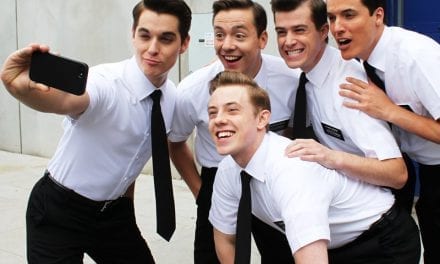SOUTH SALT LAKE — Until March 22, The Grand Theatre is taking on the daunting task of performing Jesus Christ Superstar. My dad first introduced me to the 1970 rock musical—hearing my tone-deaf father belt out every line to “Damned For All Time” on a cross country road trip is still one of my favorite memories. From when it first debuted, many people have similar personal connections to this piece. Born out of the rock movement, lyricist Tim Rice and composer Andrew Lloyd Webber created a musical that aimed to make the last 6 days of Jesus Christ’s life more personal than traditional representation. What could be more relatable in the 1970s than a sung-through rock opera?
Because of the intensity of the fast-paced rock music, the main roles in this musical are some of the hardest ones to perform. Specifically, the roles of Jesus Christ and Judas Iscariot are particularly strenuous on actors. However, the Grand’s leads don’t back away from these formidable songs.
With some of the highest rock notes in the genre, Michael Scott Johnson as Christ glides through almost every note with an easy sincerity. He portrays a multi-dimensional titular character, often burdened with responsibility and fearful of the certain future. This stage direction from director Anne Stewart Mark creates a raw portrayal of a figure often seen in a much more reverent light.
Additionally, Aaron Naylor as Judas doesn’t let Johnson keep the spotlight to himself. Naylor comes out of the gate racing with his fast-paced opening number, joyfully finding his footing in Rice’s lyrics halfway through “Heaven on Their Minds.” A tortured and predestined villain, Naylor drums up empathy for the pitiful Iscariot throughout his emotional performance.
Other standouts in the cast are McKenna Kay Jensen (Mary Magdalene) and Keefer Glade (Pilate). It is clear that both have years of experience in performing by the clarity of their voices and confidence in their stage presence. Similarly, Ryan P. Gregory (Simon) carries a fresh crispness to his voice that allows him to lead the ensemble number “Simon Zealotes.” With more practice and confidence being onstage, Gregory will be another “Superstar” to watch out for.
Ricky Pakinson (Caiaphas) and Trevor Blair (Annas) are vocally perfect as the bass and tenor priests, respectively. The only thing that makes their casting even better is the addition of Lee Markham as the 3rd Priest. Together, these three priests meld their voices in beautifully threatening songs.
The large ensemble was impressively energetic. While their timing as a group was sometimes inconsistent, anytime a member of the ensemble sang a solo, I was impressed by the precision of their voice, and they left me wanting more. Additionally, the dance talent of a small 6-person ensemble crew in “King Herod’s Song” knocked my proverbial socks off. Their jazz choreography, done by Jessica Pace, matched with Nick Morris’ stage presence as Herod, fitfully creates a show-stopping number.
The ensemble’s skills were also showcased in “The Temple,” where beggars come to Christ in need of healing. Their pleas soaring through their voices, they slowly surround Christ and begin to overwhelm Him. Pace’s choreography and Seth Miller’s lighting design combined with carefully staged performances to make it is easily the most cohesive scene in the entire show. While watching other scenes, (particularly those with only a few characters), I found myself longing for the detailed blocking that “The Temple” beautifully displayed.
The costumes, done by Shannon McCullock, range from 1980’s pop styles to 1990’s leather grunge, with Christ’s outfit rounding out the decades as an early aughts granola hippie. The spectrum of costumes aid in presenting this story anachronistically, even bridging interesting connections between Christ and modern-day prisoners, as the character sports an orange jumpsuit towards the end of the musical. Hair and make-up design by Erin McCullock underlines the wide assortment of time periods, relying heavily on eye liner to relay the message.
The entire show felt like you were at a hard rock concert, especially with the scenic design by Halee Rasmussen and Miller’s lighting design. The set boasts three levels of bare steel pipes, similar to something the band Kiss would perform on. The levels seen through the staging create useful movement opportunities for the actors, benefitting the large ensemble. Miller’s lighting immerses the audience in the feeling of a rock arena, with moving streaks of lights almost constantly illuminating the stage. While sometimes visually overwhelming, the lighting choices often create powerful images, especially when highlighting the domineering presence of the Roman Empire.
Creating powerful images through technical elements is a strong suit of the entire production team. Another example is how blood consultant Arika Shockmel smartly utilizes the cast to create lash marks on Christ’s back. When they drag their bloody hands across his back, the resulting image is both striking and moving.
Last but not least, the live orchestra is a complete show in itself. The live band of extraordinary musicians played the entirety of the show, conducted by musical director Jonathan McDonald. Hearing Jesus Christ Superstar from this phenomenal live band is worth the time to experience the show by itself.
The nostalgia of Jesus Christ Superstar carries the musical style and expedited narrative seamlessly to many audiences. Even with my own fond memories in mind, I found myself wanting more moments of stillness to connect with the characters. But this critique is a reflection on the nature of the script, not on the performances I saw at the Grand Theatre. Without a doubt, the show moves quickly, and everyone at the Grand is definitely keeping pace.





